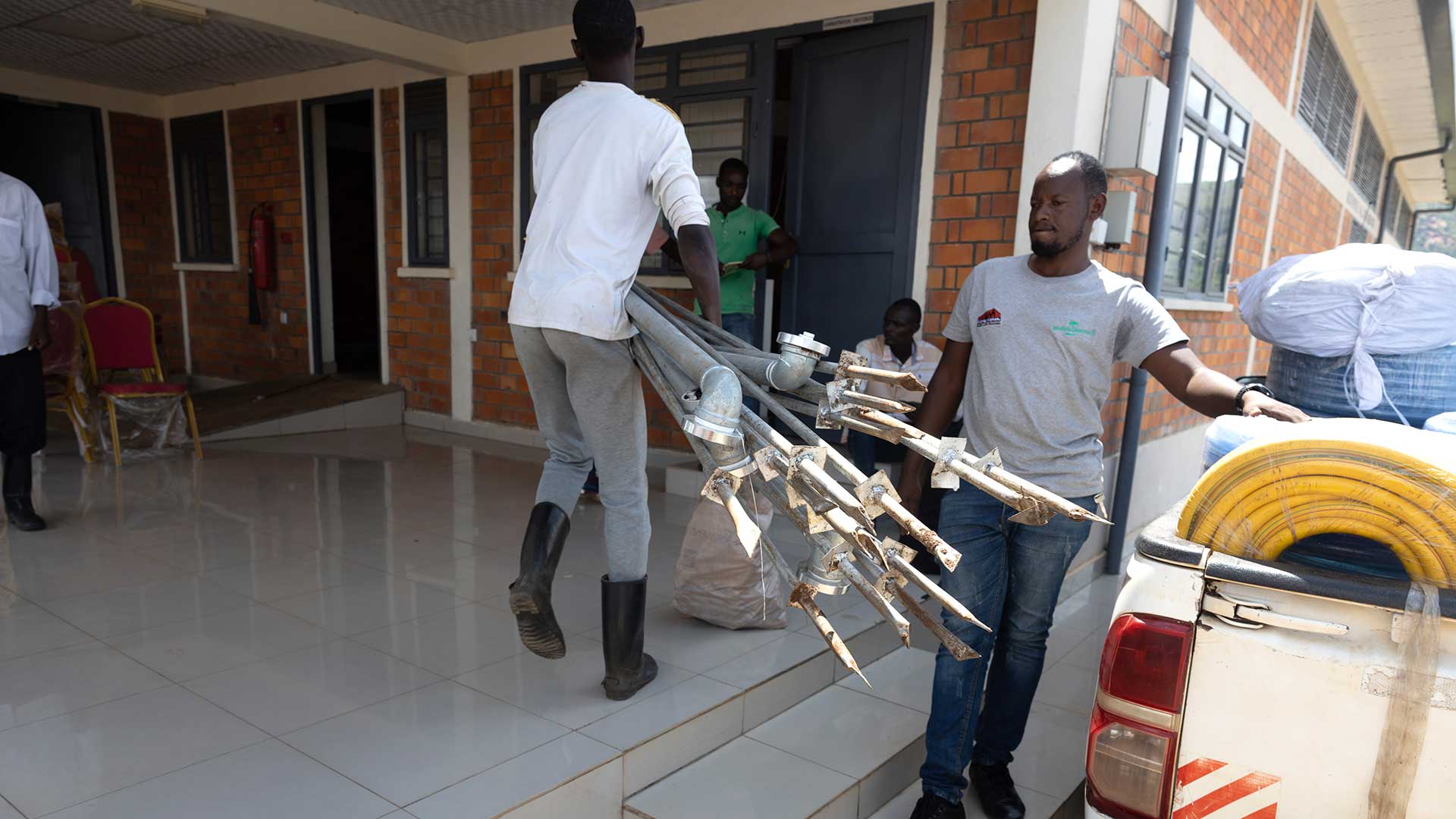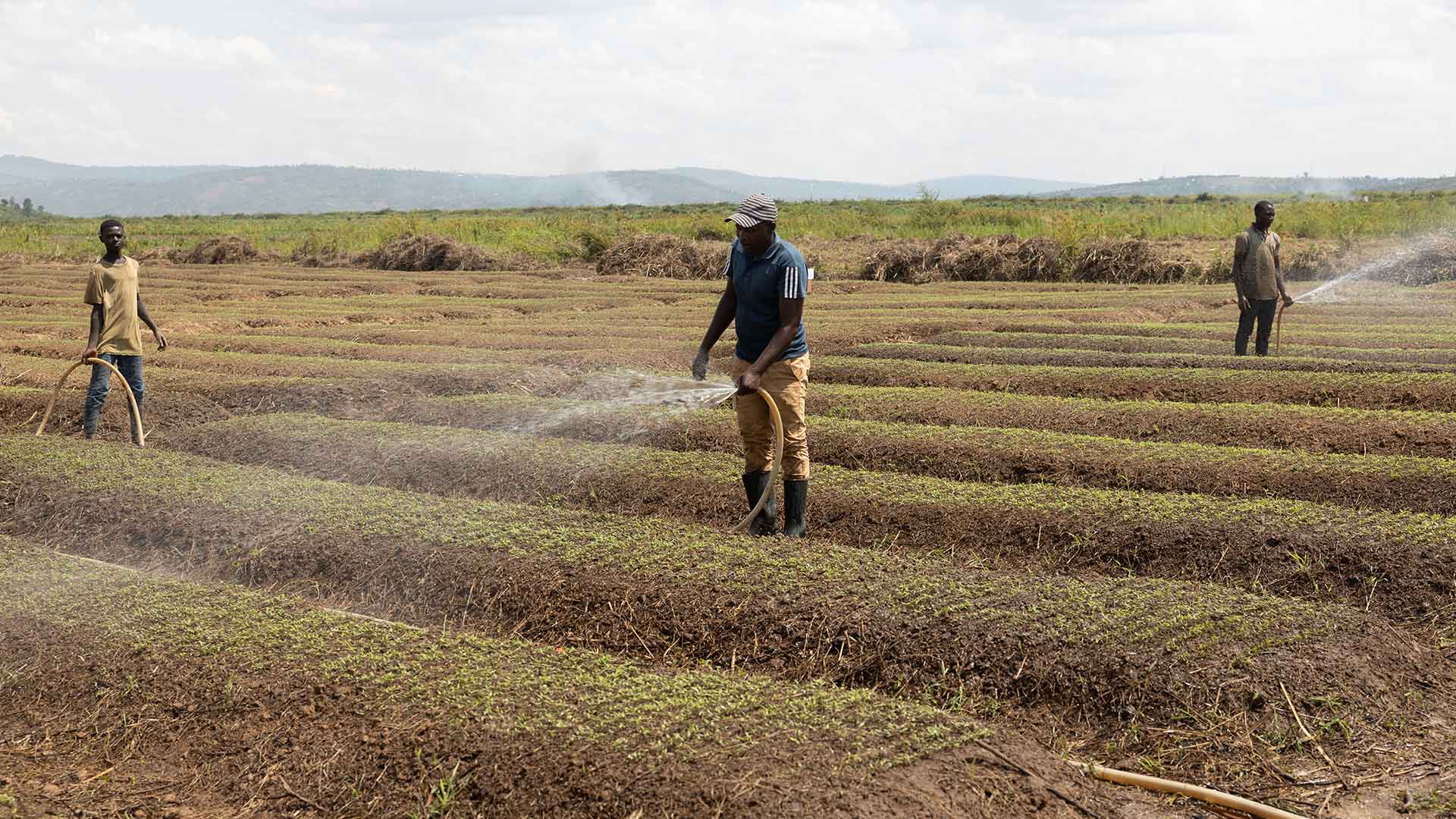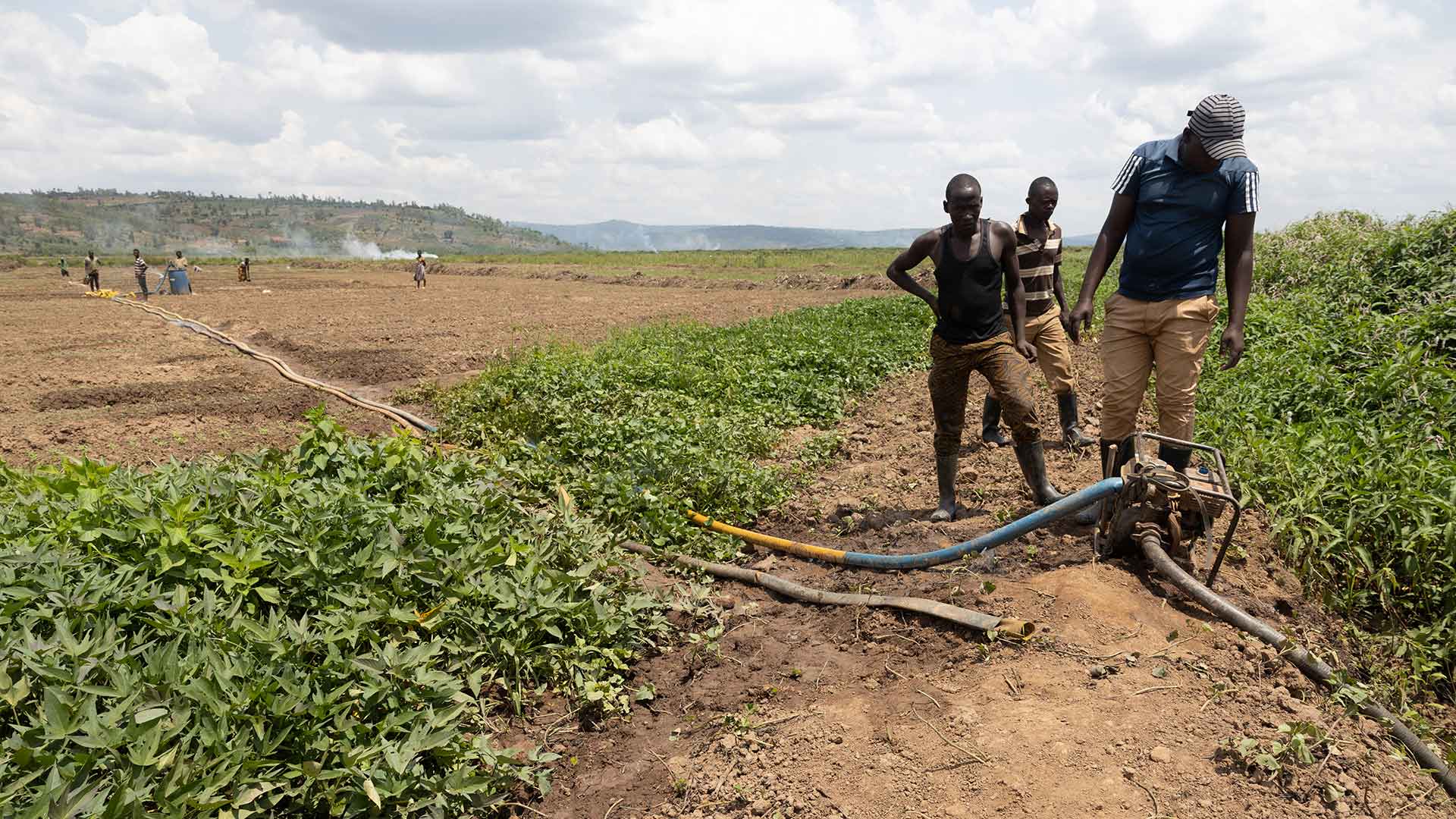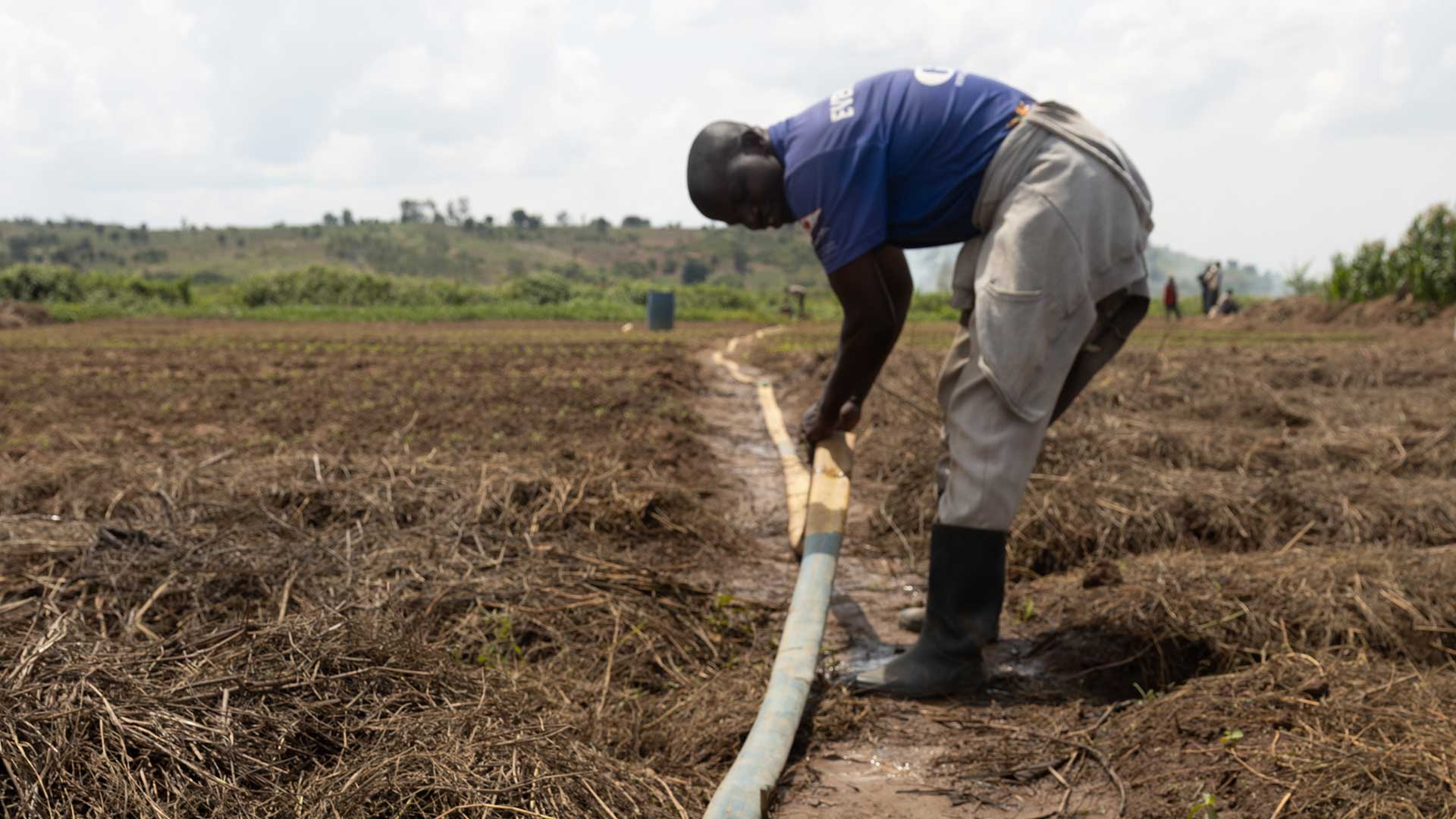Irrigation equipment ownership not always best for smallholder farmers
Small farms less than 2 hectares — or about 5 acres — account for 11% of the world's agricultural land, yet they produce 35% of the world’s food. DWFI is working to better understand the challenges faced by these smallholder farmers and find solutions to improve agricultural productivity and livelihoods. With a team of researchers on the ground in Rwanda and strong partnerships with other entities focused on the same mission, DWFI is developing tools and sharing knowledge to enhance smallholder farming success.
The current state of irrigation-as-a-service for smallholder farmers in Rwanda
In early 2023, DWFI produced a report titled “Current state of irrigation-as-a-service for smallholder farmers in Rwanda,” outlining ways in which smallholder farmers access small pumps for irrigation, various business models for providing irrigation-as-a-service, the important role of informal markets and recommendations for irrigation solutions based on DWFI’s research.
The report presents findings from dozens of field interviews on how smallholder farmers access irrigation services even when they do not own the irrigation equipment. There are various business models providing irrigation services within informal markets in Rwanda, including farmer-to-farmer lending, entrepreneur-to-farmer rentals, and water tanker trucks. Loaning and renting pumps leverages investments in irrigation equipment to increase access to irrigation and irrigated areas.
Based on observed behavior, DWFI estimates that lending and renting of small pumps has increased the actual irrigated area between 8-45 percent in the Bugesera district and 3-30 percent in the Nyagatare district. To support scaling up informal markets, DWFI recommends that the government of Rwanda encourage farmers to lend their equipment and support irrigation-as-a-service entrepreneurs with startup grants and by adjusting policies.
Most smallholder farmers rely on rain for production. However, rainfed agriculture is vulnerable to climate change and wide seasonal variability. As smallholder farmers are most affected by a lack of rain caused by climate change, small and local irrigation entrepreneurs are vital partners in helping farmers increase their production and filling the global food gap.
Irrigation pump and pipe entrepreneurs
Saraitel Sapu was interviewed by a DWFI program consultant in Rwanda. Sapu is an entrepreneur who brings water to farmers in Nyagatare district, known for its fertile soils and cattle breeding. Despite these advantages, Nyagatare district is also one of the driest regions in Rwanda.
Sapu started as a farmer who was looking for a solution for his own wilting maize. He bought two irrigation kits (two small diesel pumps and two pipes) through the government’s Small-Scale Irrigation Technology (SSIT) subsidy program, to draw water from a stream to his field. He developed an innovative approach, connecting the two pumps and pipes to deliver water over a long distance to his field.
Other farmers in the area noticed Sapu’s ability to bring water across such a distance to his farm and asked him to provide water for their crops and livestock, as well. Sapu currently is using 10 irrigation kits to deliver water to his neighbors’ farms and says there is higher demand for his rental irrigation service than he can supply. Though he acquired his first equipment through SSIT, the rest he bought at full price since they were to be used for his growing business.
Even though many of Sapu’s customers could afford to buy their own irrigation equipment, they prefer using Sapu’s service because it is more convenient and cheaper than buying, especially if they need more than one pump. This is often the case for farmers whose fields are located at least 400 metres (about 0.25 miles) from a body of water.
In addition to providing irrigation water for crops, Sapu also provides drinking water for livestock. In this case, Sapu connects multiple pumps to get water into a dam sheet located at the customer’s farm, and a full dam sheet lasts the cattle for the whole dry season.
Tanker truck entrepreneurs
DWFI researchers in Rwanda also discovered tanker truck owners or operators who were adding to their income by filling these agricultural dams which provide water for livestock. There is significant demand for this service and relatively few providers, resulting in a gap which can be filled by new agriculture entrepreneurs.
Access to water is a constraint to livestock farming in the eastern province of Rwanda, especially the Nyagatare and Gatsibo districts. Farmers in these areas usually guide their cattle to shared water points for drinking that are 3 kilometres (or about 2 miles) away, on average. This may not be far for a person, but is a long distance for cattle and can impact their health.
Cattle traveling to water may not get enough to drink, which can result in less milk production. Additionally, communal water points can increase the risk of disease spread between herds, weakening or killing the animals.
To address these challenges, some farmers have dug dams on their own farms, which collect rain during the wet seasons. During dry periods, some farmers hire water tanker trucks to fill their dams, allowing them a continued, direct supply of water for their cattle. Farmers want to keep their cattle alive and healthy, and, because of the scarcity of water tanker trucks, they are often willing to pay large sums so long as they get water for their animals.
Mapping and analysis for the business ecosystem for smallholder irrigation in Rwanda
As these challenges illustrate, there is a growing need for irrigation services for smallholder farmers – and enterprising people who are filling that need with a variety of irrigation service models.
DWFI dug deeper into this subject with another research report, “Mapping and analysis of the business ecosystem for smallholder irrigation in Rwanda,” focused on the business ecosystem for providing irrigation goods and services to smallholder farmers in Rwanda, namely the distribution and use of small irrigation pumps and associated equipment used by individual farmers or shared between a few farmers. The key findings were:
- All irrigation pumps are currently imported into Rwanda. Different irrigation technologies are sourced from different countries. Dubai is a key transshipment point and wholesale market for pumps.
- Multiple kinds of marketing channels for irrigation pumps operate within Rwanda. Price and quality differentiation are observed in the market for irrigation pumps and these influence marketing strategies. Climate variations across the country also affect the kinds of equipment marketed and sold to smallholder farmers.
- The government-run Small-Scale Irrigation Technology program subsidizes purchases of some irrigation equipment and influences the entire market. The rules around program access have fundamentally altered and segmented the retail marketing process for small-scale irrigation equipment.
- Government agronomists at the sector and district level are key influencers in irrigation pump marketing channels. The role of agronomists in technology choice and adoption has been underappreciated. Executive Summary
- Non-governmental organizations play an important role in the growth of smallholder irrigation in Rwanda. The organizations that have been the most effective in supporting the expansion of irrigation are those that provide aggregation of technical, financial, and management functions to groups of farmers.
The report and findings were based on dozens of in-person interviews, as well as associated research. DWFI researchers suggest the following potential steps to improve the business environment for small-scale irrigation equipment in Rwanda, with a focus on practical, actionable changes:
- The Small-Scale Irrigation Technology (SSIT) program has been critical to making irrigation technology available and affordable to smallholder farmers. Small improvements in its operation can thus have a large impact. DWFI researchers suggest:
- Implementing electronic and online recordkeeping within the SSIT program. This would allow forms to be completed and stored digitally and shared between government agencies. In turn, this would make the program more efficient and allow farmers to access appropriate technology more quickly than currently possible, particularly if key forms were prepopulated using available geospatial data.
- Allowing farmers to pay for equipment in installments. This would expand the irrigation retail market as, despite the government subsidy, some farmers still struggle to afford irrigation equipment. Such a scheme might be facilitated by the government and involve banks, development funds, and nongovernmental organizations.
- There is an opportunity for new businesses that serve as wholesalers and retailers of spare irrigation parts. The lack of easily accessible irrigation equipment parts is a pain point for farmers. A related recommendation is for the government to require retailers who participate in the subsidy program to carry spare parts or to have a small repair shop.
- Finally, there are many farming cooperatives, entrepreneurs, and support organizations seeking connections to support smallholder irrigation. DWFI recommends that:
- The Rwanda Cooperative Agency expand its database to include a Needs Assessment for cooperatives published online; and
- A non-governmental organization establish an irrigation-focused start- up incubator to train aspiring entrepreneurs and to facilitate access to seed money, outside investors, and potential customers.
Considering the opportunity cost of purchasing vs. using a irrigation service provider
While policymakers may generally agree on the overarching goals of farmer-led irrigation, many assume that farmers owning their own equipment is the best strategy. However, as DWFI has found through its research and in interviews with growers, this assumption should be tested and verified, carefully considering the opportunity cost of purchasing equipment over engaging in irrigation-as-a-service.
-

Pipes used for irrigation are loaded into a truck in Nyagatare district, Rwanda.
Credit: DWFI -

Farm workers irrigate a pepper nursery in Bugesera district, Rwanda.
Credit: DWFI -

A group of farm workers turn on a diesel pump to transfer water to a field in Bugesera district, Rwanda.
Credit: DWFI -

A farm worker patches a pipe with pieces from an older pipe in Bugesera district, Rwanda.
Credit: DWFI
FY 2023 Annual Report
- Overview
- Introduction
-
Research and Policy
-
Global
- Brazilian agricultural state looks to Nebraska and DWFI to sustainably manage water resources
- Irrigation equipment ownership not always best for smallholder farmers
- McCornick and Neale re-elected to World Water Council, DWFI involved in preparations for the World Water Forum
- Understanding the agtech ecosystem in India can spur future investments
-
Regional + National
- DAWN Project testing its decision-support tools with corn and soybean growers
- Water Center director helps City of Lincoln find second water source
- Water, Climate and Health program makes an impact in Nebraska
- DWFI's flux tower network now helps validate carbon credits
- Understanding climate’s effect on the health of Americans
- Groundwater transfer success stories guide water managers in meeting local water needs
- Advancements in crop modeling help adapt to climate change
-
Global
-
Education
- Faculty Fellows
-
Supported Students
- DWFI funds eight new students working on mission-related projects
- DWFI continues support of Platte Basin Timelapse interns
- Estimation of manure nutrient capacity in Nebraska minimizes water quality impacts
- Could cover crops replace offset in-season corn fertilizer?
- Congratulations to DWFI-supported student graduates
-
Communication
- Digital and online engagement connects DWFI with its global audience
- Coverage of DWFI research and events reaches more than 219 million people
- Creative storytelling used to amplify DWFI smallholder irrigation research outputs
- DWFI expertise tapped for national reports and publications
- DWFI staff receive well-deserved recognition
- 2022 Nebraska Water Center Annual Report now available
-
Outreach and Events
- Global Conference draws international audience to address water and food security
- On-farm event in Western Nebraska strengthens partnerships, spurs new ideas
- Engagement recovers to pre-pandemic levels
- Drought at forefront of discussions at Platte River Basin Conference
- 49th Annual Water Tour broadens knowledge about Nebraska water
- Nebraska Water Center seminars focus on hot topics in Nebraska Water
- Development
- Resources
- Search
FY 2023 Annual Report
- Overview
- Introduction
-
Research and Policy
-
Global
- Brazilian agricultural state looks to Nebraska and DWFI to sustainably manage water resources
- Irrigation equipment ownership not always best for smallholder farmers
- McCornick and Neale re-elected to World Water Council, DWFI involved in preparations for the World Water Forum
- Understanding the agtech ecosystem in India can spur future investments
-
Regional + National
- DAWN Project testing its decision-support tools with corn and soybean growers
- Water Center director helps City of Lincoln find second water source
- Water, Climate and Health program makes an impact in Nebraska
- DWFI's flux tower network now helps validate carbon credits
- Understanding climate’s effect on the health of Americans
- Groundwater transfer success stories guide water managers in meeting local water needs
- Advancements in crop modeling help adapt to climate change
-
Global
-
Education
- Faculty Fellows
-
Supported Students
- DWFI funds eight new students working on mission-related projects
- DWFI continues support of Platte Basin Timelapse interns
- Estimation of manure nutrient capacity in Nebraska minimizes water quality impacts
- Could cover crops replace offset in-season corn fertilizer?
- Congratulations to DWFI-supported student graduates
-
Communication
- Digital and online engagement connects DWFI with its global audience
- Coverage of DWFI research and events reaches more than 219 million people
- Creative storytelling used to amplify DWFI smallholder irrigation research outputs
- DWFI expertise tapped for national reports and publications
- DWFI staff receive well-deserved recognition
- 2022 Nebraska Water Center Annual Report now available
-
Outreach and Events
- Global Conference draws international audience to address water and food security
- On-farm event in Western Nebraska strengthens partnerships, spurs new ideas
- Engagement recovers to pre-pandemic levels
- Drought at forefront of discussions at Platte River Basin Conference
- 49th Annual Water Tour broadens knowledge about Nebraska water
- Nebraska Water Center seminars focus on hot topics in Nebraska Water
- Development
- Resources
- Search
Top image caption
A cabbage field in Rwanda.
Credit: DWFI
Related Articles
Brazilian agricultural state looks to Nebraska and DWFI to sustainably manage water resources
The Brazilian state of Mato Grosso may not appear to have much in common with Nebraska, a midwestern state of the U.S.
McCornick and Neale re-elected to World Water Council, DWFI involved in preparations for the World Water Forum
The 9th General Assembly of the World Water Council (WWC) re-elected DWFI Executive Director Peter McCornick to the council’s board of governors during its meeting in Paris in December 2022.
Understanding the agtech ecosystem in India can spur future investments
By 2030, India will have a freshwater shortfall of about 50 percent. Agriculture accounts for 78 percent of the country’s water use and irrigation innovation will be key to meeting the demand for water and food in the future.
COOKIE USAGE:
The University of Nebraska System uses cookies to give you the best online experience. By clicking "I Agree" and/or continuing to use this website without adjusting your browser settings, you accept the use of cookies.

